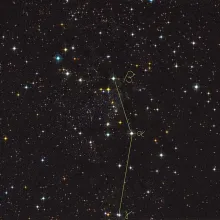LAS Autumn Equinox Sky Camp
The LAS Autumn Equinox Sky Camp is the largest star party in the UK, where hundreds of amateur astronomers meet up for a week of dark sky observing at Kelling Heath on the North Norfolk coast.
All three fields are devoted exclusively to astronomers, with a strict 'no lights' policy enforced for the whole week.
The main event day is the Saturday, with vendor trade stands, a series of talks in the afternoon and a raffle.
CalStar
Almost Heaven Star Party
The Almost Heaven Star Party (AHSP) is a stargazing event hosted at the Spruce Knob Mountain Center in West Virginia. It is known as one of the darkest sites east of the Mississippi River. The event usually draws close to 300 amateur astronomers and stargazers.
Astroblast
What is ASTROBLAST?
ASTROBLAST is a regional gathering of amateur astronomers and anyone interested in astronomy! In June 1994, ASTROBLAST became an annual event hosted by ORAS. It is held at the Oil Region Astronomy Learning Center. The event features lectures, educational sessions, a door prize drawing, and dark sky observing.
Black Forest Star Party
The Black Forest Star Party (BFSP) is an annual dark-sky amateur astronomy observing event hosted by the Central Pennsylvania Observers (CPO). Held every year since 1999, the BFSP generally spans a weekend in the late summer or early fall in Cherry Springs State Park in Potter County, Pennsylvania.
Constellation Scutum
Scutum is a small but notable constellation in the southern sky. It was introduced by the Polish astronomer Johannes Hevelius in 1684, making it one of the newer constellations in the sky. The name "Scutum" means "shield" in Latin, specifically referring to the shield of King John III Sobieski of Poland, who won the Battle of Vienna in 1683.
Constellation Andromeda
Andromeda is a large and prominent constellation in the northern sky. It is named after the mythological princess Andromeda and is best known for containing the Andromeda Galaxy, the nearest spiral galaxy to the Milky Way and one of the few galaxies visible to the naked eye. The constellation is located next to Pegasus and is easily recognizable due to its distinctive "V" shape.
Constellation Pegasus
Kivaan, CC0, via Wikimedia Commons
Pegasus is a prominent constellation in the northern sky, named after the winged horse from Greek mythology. This constellation is most recognizable by the asterism known as the "Great Square of Pegasus," which forms the body of the mythical horse. Pegasus is the seventh-largest constellation in the night sky and is home to several notable stars and deep-sky objects.
Constellation Camelopardalis
Camelopardalis is a faint and large constellation located in the northern sky. Its name is derived from the Latin word for "giraffe," which itself comes from the Greek words "kamēlos" (camel) and "pardalis" (leopard), due to the giraffe's long neck and spotted coat. The constellation is relatively obscure and consists of faint stars, making it a challenge to spot without clear, dark skies.




